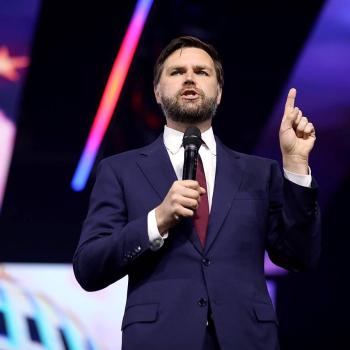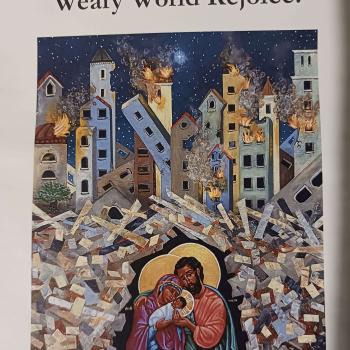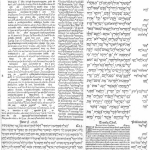As a Catholic blogger whose academic specialty is ecumenism I have felt some pressure to write something about the latest big news from the Vatican, namely the announcement about the forthcoming Apostolic Constitution that provides a kind of canonical vehicle that will allow groups of Anglicans to come into full communion with the Catholic Church. Thinking I would come up with something in fairly short order, I posted the news as my Facebook status and before long it became clear to me that this was a much more complicated issue than I had initially supposed. For fear of saying something stupid, I decided not to write anything before I had had the opportunity to talk with some people I trusted in both the Catholic and Anglican communions.
I have been fortunate in the last couple of days to tap the minds of some very astute and thoughtful theologians who work in this area. I had a long phone call with a promising young ecclesiologist of quite strong Catholic sensibilities who is married to a (female) Anglican priest. The next night I was fortunate to attend a kind of emergency dinner meeting with some faculty and grad students of Regis College (Catholic) and Wycliffe College (Anglican) here in Toronto. Included in our company was noted Anglican theologian Ephraim Radner. As he was leaving I asked him for a summary of his views. He said something very much like, “It is helpful for a few, meaningless for most and pernicious for those [and he meant those in the Anglican communion specifically] who have to deal with the fallout. Oh, and it has some very interesting, perhaps unintended, possibilities for the future of the Church.” I have chosen to use this basic framework for my reflections. The reader is advised not to assume that everything written below is the opinion of Ephraim Radner, nor even of Brett Salkeld. It is, however, a collection of things I have heard and thought in the past few days that I found noteworthy.
1. “It is useful for a few.”
The media, in some quarters, has done an awful job of indicating at whom this initiative is aimed. There is a relatively small group of Anglicans who have been petitioning Rome for years for something like this. This is not an attempt to seduce Anglicans to convert to Catholicism. The Vatican knows that, even if it were such an attempt, it wouldn’t work. Though this constitution applies in principle to all Anglicans, everyone in Rome and Canterbury knows exactly who is likely to take advantage of this. And here’s the thing: the bulk of those groups are not currently in communion with Canterbury! Many Anglican communities have broken communion with Canterbury over the years and it is precisely these groups that will make up the vast majority of what we might call Anglican-Rite Catholics. (To distinguish them from the many Anglicans who already consider themselves catholic.)
It is useful for these groups for two reasons. The first is that it allows them to maintain their Anglican traditions in areas such as piety, liturgy and even, to a degree, canon law. This has been commented on extensively elsewhere. The second reason is not something I have seen elsewhere (though I haven’t read everything). It allows them to be received into communion with the Bishop of Rome and the Catholic Church without converting. Yes, you read that right. Individual Anglicans have, of course, always had the option of converting to Roman Catholicism (or Ukrainian Catholicism for that matter). These people did not want to convert; they wanted to return to full communion. Ecumenically this is a huge and significant difference. In the history of the Church, we have never, to my knowledge, referred to the healing of schism as conversion. After the Council of Florence we didn’t talk about having converted the Orthodox. We certainly don’t talk about union with the East coming about today by means of the conversion of Catholics into Orthodox or vice versa. This is the healing of schism, not conversion en masse.
2. “It is meaningless for most.”
When the Toronto Star heard that the conservative Anglicans were being targeted by Rome for ‘conversion,’ they decided to phone some and ask them what they thought about it. The fellow they got a hold of said he and his fellow conservative Anglicans had no interest in a Church with a Pope and a bunch of extra-biblical Marian dogmas. Like elsewhere, in Anglicanism, conservative is not a univocal term. The “conservatives” in question are a tiny minority of Anglicans who often have little in common with other conservative elements in the Anglican Communion. Radner even wonders whether Rome knows much detail about the unique characteristics of the groups it is courting here and suggests it might be taking on some baggage unwittingly.
What is clear is that for the vast majority of Anglicans this means nothing. From the socially progressive Anglicans who have embraced same-sex marriage and practicing gay bishops, to social conservatives wary of the papacy, to people with deep Catholic sensibilities liturgically, ecclesiologically and ethically who simply cannot accept a ban on women clergy (including many former Catholics), for most Anglicans much work is still required before union with Rome is a possibility.
Suggestions that this could in any way lead to the collapse of Anglicanism seem to me beyond far-fetched. Anglicanism might very well be near collapse, but it will have nothing to do with a few Anglicans who were already out of the communion being reconciled to Rome.
3. “It is pernicious for some.”
One of the problems with discussing things at this stage is that we do not have the document in hand. John Allen Jr. does an excellent job of spelling out some of the canonical issues that arise from the Catholic point of view. From the Anglican point of view several other questions arise. What exactly will the Liturgy look like? Will the Book of Common Prayer be the standard text? (And, if so, what does this mean for previous Catholic condemnations of the BCP? As I understand it, these condemnations are not unrelated to the condemnation of Anglican orders.) One news report I read suggested that married Anglican men who are neither ordained nor in seminary will be considered for the Catholic priesthood on a case-by-case basis. Is this at all likely?
Perhaps even more problematic is the kind of legwork that is going to be needed from the Pontifical Council for Promoting Christian Unity (notoriously absent at the Vatican press conference) and Canterbury to ensure that this does not have a negative impact on existing ecumenical dialogues. Bishops Nichols and Williams noted at their press conference in England that without ARCIC this kind of thing would be unimaginable, and I think they’re right. Even though the new Anglican-Rite Catholics do not represent Anglicanism as a whole, it is true that neither party could have imagined anything but a mass conversion without the insights of the ecumenical movement. Nevertheless, ARCIC never imagined disaffected Anglicans uniting with Rome independent of the rest of the communion. I, for one, think that Williams has been most gracious in this regard.
Apparently both Williams and Walter Kasper were given two weeks’ notice of this announcement. That’s not a lot of time for people who have worked on these issues for decades. (Though it is an improvement from lifting the excommunications of the SSPX bishops and not telling Kasper at all.) Because this is about responding to a request rather than making an initiative, I personally don’t think this should do any serious damage to existing ecumenical work. It’s not like Canterbury didn’t know something was coming. But it certainly could have hurt relations if Williams had shown his frustration at the way that things have been communicated. And I think it’s naïve to suggest he didn’t have any. This has put him in a pretty tough spot.
4. “Interesting, and perhaps unintended, possibilities.”
Despite attempts at finding analogies, what this Apostolic Constitution creates is actually quite unique in terms of canon law. Some have spoken of uniatism, but that falls apart when one considers that in the 16th century Rome was actively proselytizing in the East, while in this case it is Rome who has been approached for unity. Secondly, in those cases Rome said something like “The Ukrainian Church in communion with us is the real Ukrainian Church” (though that position is obviously no longer held). No one is suggesting that the few Anglicans who unite with Rome constitute the real Church of England. Furthermore, those groups are treated as (at least semi-) autonomous Churches. There is no suggestion that this group of Anglicans constitutes a “Church.”
Though these Anglican-Rite Catholics will have a unique rite like the Malabar or the Maronites, the structure will be much more like a diocese. But again, not quite. The ordinariate runs kind of like a diocese without borders, but it is not a personal prelature, which truly has no borders. It will be tied to some locale, though it is not yet clear how. Think about it this way: if it truly has no borders, could there be more than one of them in the world? What would it mean to have several ordinariates (and plurality is what is envisioned in everything we’ve seen so far) without borders which all deal with the same rite and the same group of the faithful? Another way that the ordinariate is unlike a diocese is that it will not necessarily be headed by a bishop. But that is an important part of the definition of diocese.
These ordinariates are a rite without a Church (in this way more like Milan than the Ukraine) and, potentially at least, a diocese without a bishop. In other words, they are a brand-new animal.
And it is precisely their novelty that carries the interesting possibilities.
At dinner last night one man spoke up and said, “As a Mennonite, this looks like an answer to what I’ve been asking: Can I be a Mennonite and a Catholic at the same time? How can I be in communion with the bishop of Rome, and thus the whole Church, without forsaking my Mennonite identity?”
These ordinariates give us a way to imagine just that. To those who suggest that Williams and Nichols were just blowing smoke when they credited ARCIC for this move, I suggest that this is exactly where ARCIC played a key role. Catholics and Anglicans worked together for decades on the presumption that mass conversion was not a satisfactory result.
One of the problems of the ecumenical movement is that it has never had a clear picture of what a return to full communion would actually look like. Before Vatican II, Catholics assumed that, in the West at least, it would look exactly like the Roman Catholic Church. Since the rejection of this ‘ecumenism of return’ and our entry into the wider ecumenical project, it has been unclear how reunion would take place. Despite all the advances that have been made in theological agreement, not a single group of western Christians had reunited with Rome – until this week!
It seems to me that no matter what one thinks of the way this was handled by the Vatican, or by the media, or what one thinks of the particular group of Christians that will come into communion with Rome, or any of the difficulties it creates canonically and logistically, what may stand out from this announcement in 500 years is the fact that Rome has found a way to reunite with other western Christians without requiring their conversion. This gives all of us in ecumenical dialogue a kick in the imagination. We now have a picture and a precedent with which to work when discussing the reunion of the western Church.
If the Anglicans can keep their liturgy and even some canon law, what might other groups be able to bring to a reunited Church? Doctrinally the question is even more interesting. And, before we get too hasty in suggesting that there can be no divergence of doctrine whatsoever, it will be useful to remind ourselves just how easygoing Catholics can be on the filioque when we talk to our Eastern brothers and sisters.
Interestingly, one of the strengths of this canonical construction is that it works well for groups large and small. One of the difficulties of doing ecumenical dialogue with Protestants is that it is difficult to find someone to speak for such groups given the diversity of structures and lack of centralized authority. Ironically enough, this vehicle might be better suited to congregationalist Christians than episcopal ones.
This does not mean that there are not immense difficulties ahead of us. This does not mean that every group that seeks unity with the Bishop of Rome will use this exact procedure. What it does mean is that we have made a start.
Pope Benedict has often been portrayed as a radical conservative. Some suggest he wants to revoke the Second Vatican Council. They are worried that his overtures towards the Society of St. Pius X are a distressing trend away from mainstream ecumenism. Many point out that the Anglicans who will be joining us are not so different from the SSPX. Some ask if he is trying to artificially tip the scales within the Catholic Church by engaging these groups. Whatever one’s take on those issues, the divide between the CDF and the PCPCU is indeed troubling.
But there is one thing that this Apostolic Constitution makes clear, and it is perhaps of historic importance: the ecumenism of return is dead and Pope Benedict XVI is the man who buried it.
Brett Salkeld is a doctoral student in theology at Regis College in Toronto. He is a father of two (so far) and husband of one.












